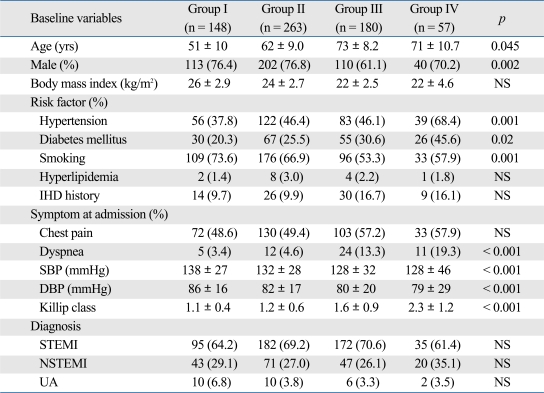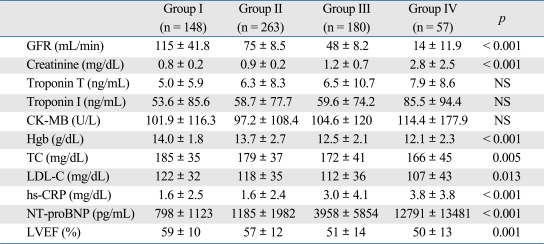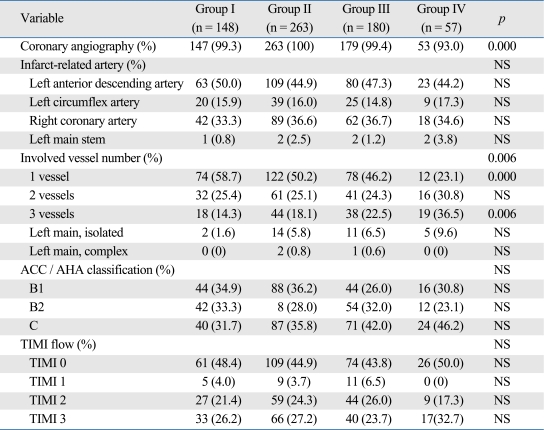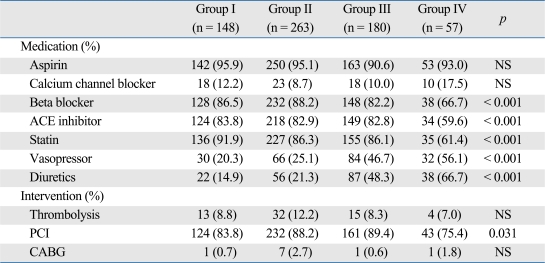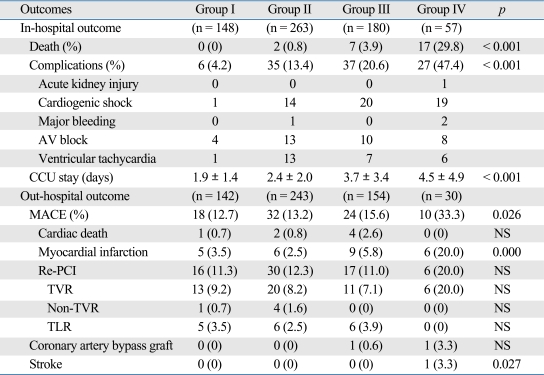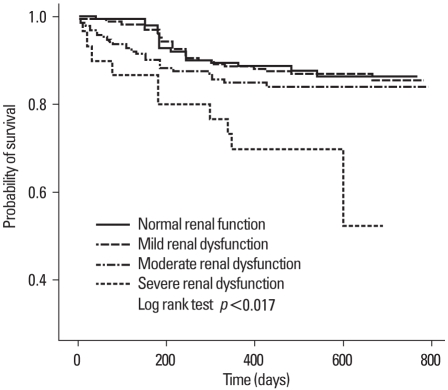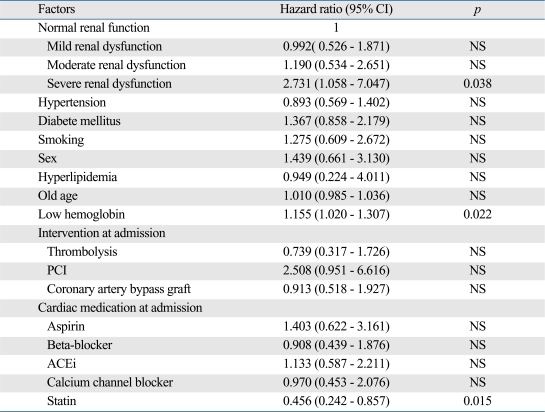Abstract
Purpose
The present study aimed to compare the clinical outcomes and to investigate prognostic factors of acute coronary syndrome (ACS) in patients with renal dysfunction (RD).
Materials and Methods
The study was a retrospective cohort of 648 adult patients admitted with ACS between October 2005 and December 2006. The estimated glomerular filtration rate (GFR) was classified into 4 levels: 1) normal, GFR greater than 90 mL/min/1.73 m2; 2) mild RD, GFR of 60 to 90 mL/min/1.73 m2; 3) moderate RD, GFR of 30 to 60 mL/min/1.73 m2; and 4) severe RD, GFR less than 30 mL/min/1.73 m2. Primary end points were death and complication in hospital courses. Secondary end points were major adverse cardiac event (MACE) during follow-up.
Results
The median follow-up was 505 ± 183 days, the mean age was 63 ± 12 years, and 71.8 percent of the group were men. A graded association was observed between severity of RD and clinical outcomes. Severe RD independently predicted MACE [hazard ratio, 2.731; 95% confidence interval (CI), 1.058 to 7.047, p = 0.038]. Low hemoglobin level was also an independent risk factor for MACE (hazard ratio, 1.155; 95% CI, 1.020 to 1.307, p = 0.022). Use of lipid-lowering therapy (hazard ratio, 0.456; 95% CI, 0.242 to 0.857, p = 0.015) was associated with reduced risk for MACE.
Conclusion
Severe RD and low hemoglobin level were an independent risk factors for the mortality and complications of ACS, while lipid-lowering therapy was associated with reduced risk.
Keywords: Acute coronary syndrome, glomerular filtration rate, risk factors
INTRODUCTION
Chronic kidney disease (CKD) is strongly associated with very high mortality rates and accelerated cardiovascular disease (CVD).1 A main concern for individuals with CKD is the incidence of CVD events, including coronary heart disease, cerebrovascular disease, and peripheral vascular disease.2-7 The proportion of long-term and elderly patients was markedly increased in patients with CKD in Korea and also was associated with increased prevalence of ischemic heart disease (IHD).8
A recent meta-analysis provided strong evidence that individuals with renal insufficiency experience a 1.4- to 3.7-fold increased risk for CVD mortality compared with their counterparts without renal insufficiency.2 An independent, graded association was observed between a reduced estimated glomerular filtration rate (GFR) and the risk of death, cardiovascular events, and hospitalization in a large, community based population.6 Despite strong evidence linking CKD to worse outcomes, however, the impact of CKD on mortality and morbidity in patients with acute coronary syndrome (ACS) is probably underappreciated, and patients with CKD receiving acute cardiac care may not be treated as aggressively or with evidence-based therapies as frequently as those with normal renal function.9-13
The present study was undertaken to evaluate the effect of renal dysfunction (RD) on clinical outcomes that include death, complication and major adverse cardiac event (MACE) in patients with ACS. In addition, we explored prognostic factors of ACS in relation to severity of RD.
MATERIALS AND METHODS
Study population
This study was a retrospective cohort of consecutive 648 patients (63 ± 12 years, men 71.8%) who were admitted to our hospital between October 2005 and December 2006, whose discharge diagnosis by cardiac enzyme and electrocardiogram was ACS. Coronary angiography was performed for 642 patients. Secondary end points were analyzed in 569 patients, excluding death of 26 patients and 53 patients with transfer to other hospitals in hospital courses or loss during follow-up. The Chonnam National University Hospital Ethics Committee approved this study.
Definitions
Primary end points were death and complication in hospital courses. Secondary end points were MACE that included cardiogenic death, myocardial infarction or stroke, and need for emergency or elective repeat revascularization or coronary artery bypass graft (CABG) during follow up. The abbreviated Modification of Diet in Renal Disease formula was used to estimate GFR in milliliters per minute per 1.73 m2 from the creatinine level.14 Estimated GFR was classified into 4 levels; 1) normal, 148 patients (51 ± 10 years, men 76.4%), GFR ≥ 90 mL/min/1.73 m2; 2) mild RD, 263 patients (62 ± 9.0 years, men 76.8%), 60 < GFR < 90 mL/min/1.73m2; 3) moderate RD, 180 patients (73 ± 8.2 years, men 61.1%), 30 < GFR < 60 mL/min/1.73m2; 4) severe RD, 57 patients (71 ± 10.7 years, men 70.2%), GFR ≤ 30 mL/min/1.73m2.
Laboratory analysis and left ventricular ejection fraction
Laboratory data, which included total cholesterol (TC), low-density lipoprotein (LDL-C), hemoglobin, high sensitive C-reactive protein (hs-CRP), N-terminal Pro B-type natriuretic peptide (NT-proBNP), serum creatinine, troponin-T, troponin-I, and creatine kinase-MB, were collected before coronary angiography on admission. The serum levels of TC and LDL-C were measured by standard enzymatic methods. hs-CRP was analyzed turbidimetrically using sheep antibodies against human CRP; this has been validated against the Dade-Behring method.15 The serum NT-proBNP and cardiac enzyme levels were measured by an electrochemiluminescence "sandwich" immunoassay method.16
Left ventricular ejection fraction (LVEF) was assessed by performing transthoracic echocardiography by using a Teicholz method before coronary angiography.
Data collection
Baseline variables were age, gender, body mass index (BMI), and coronary risk factors, which included hypertension (defined as history of hypertension, admission blood pressure > 140 mmHg systolic or > 90 mmHg diastolic), current smoking, previous history of IHD, hyperlipidemia (defined as history of hyperlipidemia, TC level of 240 mg/dL, or LDL-C level > 101 mg/dL), or diabetes mellitus [defined as history of diabetes mellitus (DM) or random blood glucose level > 200 mg/dL], clinical symptoms on admission (chest pain or dyspnea), and Killips class.
Use of certain medications was recorded on admission [aspirin, angiotensin converting enzyme inhibitor (ACEi), calcium channel blocker (CCB), statin, beta blocker (BB) or heparin]. Surgical interventions [CABG, thrombolysis, or percutaneous coronary intervention (PCI)] and coronary care unit (CCU) stay were recorded.
The death and complications in hospital courses were recorded [cardiogenic shock, ventricular tarchycardia (VT) and fibrillation which needed anti-arrhythmic drug or defibrillation, atrioventricular (AV) block which needed temporary cardiac pacemaker inserion, repeated ischemia or myocardial infarction, cerebrovascular accident, major bleeding, acute kidney injury (AKI), multiorgan failure, newly developed heart failure and sepsis]. If more than two complications in one patient were developed, types of each complication were recorded. After discharge, newly developed MACE during follow-up was recorded.
Statistical analysis
Continuous variables with normal distributions were expressed as means ± SD for 4 groups, based on the level of kidney function, and they were compared with the use of one-way ANOVA test. Categorical variables were compared with the use of the chi-square test, wherever appropriate. The secondary survival outcome was summarized by means of unadjusted Kaplan-Meier estimates stratified into the 4 kidney function groups.
Cox proportional hazards modeling was used to examine the relationship of survival with a prespecified list of risk factors, including kidney function on MACE. Analyses were adjusted for hypertension, DM, smoking, gender, hyperlipidemia, age, hemoglobin, surgical interventions, and medication (aspirin, BB, ACEi, CCB and statin). A p value less than 0.05 was deemed as significant. Statistical analysis was done with the Statistical Package for Social Sciences software (SPSS 13.0 for Windows).
RESULTS
Baseline characteristics
A total of 648 patients were included in the present study (ST-segment elevation myocardial infarction; 67.7%, non-ST-segment myocardial infarction; 27.9%, unstable angina; 4.3%). Table 1 lists baseline characteristics of patients based on renal function. The median follow up was 505 ± 183 days; mean age was 63 ± 12 years; 71.8% were men; and mean BMI was 24 ± 3.1. Hypertension was present in 46.3%; DM, 27.5%; current smoking, 63.9%; hyperlipidemia, 2.3%; and 12.3% had a history of IHD. More severe RD was associated with older age, hypertension, DM, dyspnea and high Killip class. However, percentages of patients who smoked at the time of the study were lower in those with more severe RD.
Table 1.
Baseline Characteristics
IHD, ischemic heart disease; SBP, systolic blood pressure; DBP, diastolic blood pressure; STEMI, ST-segment elevation myocardial infarction; NSTEMI, non-ST-segment myocardial infarction; UA, unstable angina; NS, not significant.
Biochemical parameters, LVEF, and coronary angiographic findings
Table 2 summarizes baseline continuous variables. Hemoglobin, TC, LDL-C levels and LVEF were lower, while hs-CRP and NT-proBNP levels were higher in patients with more severe degree RD. Table 3 shows data of coronary angiography according to changes of renal function. The number of involved vessel was higher in patients with more severe RD. In contrast, the prevalence of 1 vessel disease was increased according to increased GFR. Other findings such as Infarct-related artery, American College of Cardiology / American Heart Association classification15 and Thrombolysis In Myocardial Infarction flow were not significantly different among the groups.
Table 2.
Biochemical Parameters and Left Ventricular Ejection Fraction (LVEF)
GFR, glomerular filtration rate; Hgb, hemoglobin; TC, total cholesterol; LDL, low density lipoprotein; hs-CRP, high sensitive C-reactive protein; NT-proBNP, N-terminal pro B-type natriuretic peptide; CK-MB, creatine kinase-MB; NS, not significant.
Table 3.
Baseline Coronary Angiographic Findings
ACC / AHA, American College of Cardiology / American Heart Association; TIMI, thrombolysis in myocardial infarction; NS, not significant.
Hospital treatment on admission by kidney function
Table 4 lists medical and surgical utilization in the cohort. The use of aspirin and CCB was not different among the groups. The presence of moderate or severe RD was negatively associated with the use of BB, ACEi, and statin. Use of these agents was greater in the groups with preserved renal function. In contrast, more severe RD was associated with the use of vasopressor and diuretics. In surgical utilization, the use of thrombolysis and CABG was not different among the groups, but PCI was lesser in the groups with more advanced RD.
Table 4.
Hospital Treatment on Admission according to Kidney Function
ACE inhibitor, angiotensin converting enzyme inhibitor; PCI, percutaneous coronary intervention; CABG, coronary artery bypass graft; NS, not significant.
Outcomes according to the estimated GFR
Table 5 lists in-hospital and out-hospital outcomes according to the estimated GFR. The estimated in-hospital death and complication rate was 0% and 4.2%, respectively, in normal renal function. Cardiogenic shock was in 1 patient; AV block in 4 patients; VT in 1 patient. In hospital death and complication was 0.8% and 13.4%, respectively, for mild RD. Cardiogenic shock was in 14 patients; major bleeding in 1 patient; AV block in 13 patients; VT in 13 patients with complication. In hospital death and complication was 3.9% and 20.6%, respectively, for moderate RD. Cardiogenic shock in 20 patients; AV block in 10 patients; VT in 7 patients in type of complication. The in hospital death and complication was 3.9% and 20.6%, respectively, for severe RD. AKI in 1 patient; Cardiogenic shock in 19 patients; major bleeding in 2 patients; AV block in 8 patients; VT in 6 patients in type of complication. Mean length of CCU stay was 1.9 ± 1.4 days in patients with normal renal function and 4.5 ± 4.9 days in those with severe RD. The incidence of MACE during follow up was 12.7% in patients with normal renal function and 33.3% in those with severe RD. The incidence of myocardial infarction and stroke were higher in patients with more severe RD. A graded association was observed between severity of RD and the risk of in-hospital death, complication and CCU stay of ACS, and the incidence of MACE during follow-up.
Table 5.
Outcomes according to the Estimated Glomerular Filtration Rate
AV, atrioventricular; CCU, coronary care unit; MACE, major adverse cardiac event; PCI, percutaneous coronary intervention; TVR, target vessel revascularization; TLR, target lesion revascularization.
Fig. 1 illustrates Kaplan-Meier survival in patients with ACS according to renal function during follow-up. Severe RD group showed lower probability of event-free survival compared with the other groups.
Fig. 1.
Kaplan-Meier survival in patients with acute coronary syndrome according to renal function during follow-up. Severe renal dysfunction group showed lower probability of event-free survival than the other groups.
Cox regression analysis for MACE during follow-up
Table 6 lists factors found to be significant independent predictors of MACE in the adjusted Cox proportional hazards model. Severe RD [hazard ratio, 2.731; 95% confidence interval (CI), 1.058 to 7.047, p = 0.038], but not mild and moderate RD, independently predicted death. Other predictors of mortality were low hemoglobin level (hazard ratio, 1.155; 95% CI, 1.020 to1.307, p = 0.022), Use of lipid-lowering therapy (hazard ratio, 0.456; 95% CI, 0.242 to 0.857, p = 0.015) was associated with reduced risk for MACE.
Table 6.
Cox Regression Analysis for Major Adverse Cardiac Event during Follow Up
CI, confidence interval; PCI, percutaneous coronary intervention; ACEi, angiotensin converting enzyme inhibitor; NS, not significant.
DISCUSSION
The most common cause of death in patients with CKD was IHD.1 Although it did not completely exclude absolute impacts and many questions about the relationship between CKD and mortality and morbidity after development of ACS, previous reports suggested that more severe RD was significant independent predictors of cardiovascular event.2-7 Furthermore, recent studies suggested that mild renal impairment was an independent predictor of long-term mortality in patients with known or suspected coronary artery disease.9-11,18-20 The risk factors for high prevalence of IHD in CKD patients suggested the importance of traditional risk factors (hypertension, DM, smoking, and hyperlipidemia) as well as novel risk factors [C-reactive protein, fibrinogen, interleukin-6, factor VIIIc, lipoprotein(a) and hemoglobin].21 Consequently, Schiffrin et al.22 reported that aggressive risk factor modification in CKD prevented the development of new cardiovascular event.
The present study compared the clinical outcomes and investigated prognostic factors of ACS in patients with RD. The result showed that more severe RD was associated with hypertension and DM as risk factors of ACS, being consistent with the result of Sarnak et al.1 More severe RD was significantly associated with dyspnea and high Killip class in clinical manifestations on admission and increased NT-proBNP levels. Because increased NT-proBNP in patients with severe RD was correlated with severity of heart failure, left ventricle dysfunction, volume overload and IHD, it was assumed that clinically severe manifestations like cardiogenic shock and pulmonary congestion with dyspnea were developed in patients with severe RD.23 Conversely, LDL-C level was significantly lower in patients with more severe RD. The age-related decline in GFR and the lower prevalence of hyperlipidemia might indicate increased malnutrition and inflammation in patients with severe RD.14,24
Major CVD trials often exclude patients with renal disease, therefore, did not elucidate the effect of interventions and treatment on patients with renal disease.9-11,13 Our analysis confirmed the use of ACEi and BB in improving survival after development of ACS and PCI declined in patients with severe RD, and it is highly possible that complications like cardiogenic shock and AV block were increased while declined in GFR.
Individuals with CKD become progressively malnourished, as evidenced by low levels of albumin, prealbumin, and transferrin, which has been suggested to be a mechanism for activation of inflammation.24,25 Renal failure causes changes in plasma components and endothelial structure and function, thereby favoring vascular injury, which may play a role as a trigger for inflammatory response.26-28 Between 30 and 50% of CKD patients have elevated serum levels of inflammatory markers such as C-reactive protein, interleukin-6, and tumor necrosis factor-α. Progressive deterioration of renal function in CKD may lead to dyslipidemia or accumulation of uremic toxins, which can stimulate oxidative stress and inflammation, and hence, contribute to endothelial dysfunction and progression of atherosclerosis.22,28 Consequently, there have been numerous studies conducted on the relationship between inflammatory markers and CVD in CKD patients. Shlipak et al.21 and Menon et al.29 reported that increased inflammatory marker was a risk factor of cardiovascular event. Our present analysis confirmed that hs-CRP level and the number of involved vessel on coronary angiography were higher in patients with more severe RD, nevertheless, were not significant independent predictors of MACE.
The relationship between renal disease and cardiovascular mortality has also been shown to extend to subjects with more moderate degrees of renal functional impairment. The Framingham Heart Study was among the first to assess mild renal insufficiency and its association with death and adverse cardiovascular events in the general population.30 More recently, in a large study that incorporated a diverse population of adults, Go et al.6 clearly demonstrated an independent and graded (inverse) correlation between decreasing levels of renal function and increasing event rates of cardiovascular morbidity and death. In our study, a graded association was observed between severity of RD and the risk of death, complication of ACS, CCU stay, and newly developed MACE including myocardial infarction and stroke. Severe, but not mild and moderate, RD independently predicted MACE. Thus, patients with more severe RD needed intense treatment and close surveillance for improved clinical outcomes.
Consistent with previous reports, we found anemia as a risk factor for MACE after ACS.31,32 The relationship between cardiovascular event and anemia in CKD patients was a set of complex and interrelated phenomena, and remains to be further elucidated. Several mechanisms may contribute to the association between anemia and adverse clinical outcomes. Low hematocrit may predispose to chronic myocardial hypoxia, left ventricular dilatation and dysfunction, which leads to increased frequency of CVD.33 In addition, anemia is associated with increased oxidative stress since erythrocytes are a major antioxidants.34 In this context, correction of anemia in patients with CKD has been shown to reduce hospitalization rate and hospital stay.35
Compelling data derived primarily from randomized controlled trials have shown benefits of aspirin, ACEi, BB, and statins, in preventing recurrent events and improving survival after ACS developed.36 We found that the use of lipid-lowering therapy, but not BB and ACEi, was associated with reduced risk for MACE. It is in support of previous reports about correction of dyslipidemia for prevention of CVD in CKD patients.1,21,22,37 Because dyslipidemia associated with CKD appears to play a role in the enhanced cardiovascular risk of these patients, treatment of dyslipidemia conversely may ameliorate the progression of ACS along with its' anti-inflammatory effects.38
In conclusion, severe RD and low hemoglobin level were an independent risk factors for MACE. Use of lipid-lowering was associated with reduced risk for MACE in ACS patients. Also, because a graded association was observed between severity of RD and the risk of inhospital death, complication and CCU stay of ACS, patients with renal dysfunction need aggressive intervention for improved prognosis and correction of cardiovascular risk factors.
ACKNOWLEDGEMENTS
This study was supported by a grant from Chonnam National University Hospital Research Institute of Clinical Medicine (CRI08021-1) and by a grant of the Korea Healthcare technology R&D Project, Ministry for Health, Welfare and Family Affairs, Republic of Korea (A084869).
Footnotes
The authors have no financial conflicts of interest.
References
- 1.Sarnak MJ, Levey AS, Schoolwerth AC, Coresh J, Culleton B, Hamm LL, et al. Kidney disease as a risk factor for development of cardiovascular disease: a statement from the American Heart Association Councils on Kidney in Cardiovascular Disease, High Blood Pressure Research, Clinical Cardiology, and Epidemiology and Prevention. Hypertension. 2003;42:1050–1065. doi: 10.1161/01.HYP.0000102971.85504.7c. [DOI] [PubMed] [Google Scholar]
- 2.Tonelli M, Wiebe N, Culleton B, House A, Rabbat C, Fok M, et al. Chronic kidney disease and mortality risk: a systematic review. J Am Soc Nephrol. 2006;17:2034–2047. doi: 10.1681/ASN.2005101085. [DOI] [PubMed] [Google Scholar]
- 3.Muntner P, He J, Hamm L, Loria C, Whelton PK. Renal insufficiency and subsequent death resulting from cardiovascular disease in the United States. J Am Soc Nephrol. 2002;13:745–753. doi: 10.1681/ASN.V133745. [DOI] [PubMed] [Google Scholar]
- 4.Manjunath G, Tighiouart H, Ibrahim H, MacLeod B, Salem DN, Griffith JL, et al. Level of kidney function as a risk factor for atherosclerotic cardiovascular outcomes in the community. J Am Coll Cardiol. 2003;41:47–55. doi: 10.1016/s0735-1097(02)02663-3. [DOI] [PubMed] [Google Scholar]
- 5.Anavekar NS, McMurray JJ, Velazquez EJ, Solomon SD, Kober L, Rouleau JL, et al. Relation between renal dysfunction and cardiovascular outcomes after myocardial infarction. N Engl J Med. 2004;351:1285–1295. doi: 10.1056/NEJMoa041365. [DOI] [PubMed] [Google Scholar]
- 6.Go AS, Chertow GM, Fan D, McCulloch CE, Hsu CY. Chronic kidney disease and the risks of death, cardiovascular events, and hospitalization. N Engl J Med. 2004;351:1296–1305. doi: 10.1056/NEJMoa041031. [DOI] [PubMed] [Google Scholar]
- 7.Weiner DE, Tighiouart H, Amin MG, Stark PC, MacLeod B, Griffith JL, et al. Chronic kidney disease as a risk factor for cardiovascular disease and all-cause mortality: a pooled analysis of community-based studies. J Am Soc Nephrol. 2004;15:1307–1315. doi: 10.1097/01.asn.0000123691.46138.e2. [DOI] [PubMed] [Google Scholar]
- 8.Ahn SJ, Choi EJ. Renal Replacement Therapy in Korea: Insan Memorial Registry 1997. Korean J Nephrol. 1999;18:1–15. [Google Scholar]
- 9.Shlipak MG, Heidenreich PA, Noguchi H, Chertow GM, Browner WS, McClellan MB. Association of renal insufficiency with treatment and outcomes after myocardial infarction in elderly patients. Ann Intern Med. 2002;137:555–562. doi: 10.7326/0003-4819-137-7-200210010-00006. [DOI] [PubMed] [Google Scholar]
- 10.Wright RS, Reeder GS, Herzog CA, Albright RC, Williams BA, Dvorak DL, et al. Acute myocardial infarction and renal dysfunction: a high-risk combination. Ann Intern Med. 2002;137:563–570. doi: 10.7326/0003-4819-137-7-200210010-00007. [DOI] [PubMed] [Google Scholar]
- 11.Beattie JN, Soman SS, Sandberg KR, Yee J, Borzak S, Garg M, et al. Determinants of mortality after myocardial infarction in patients with advanced renal dysfunction. Am J Kidney Dis. 2001;37:1191–1200. doi: 10.1053/ajkd.2001.24522. [DOI] [PubMed] [Google Scholar]
- 12.Coca SG, Krumholz HM, Garg AX, Parikh CR. Underrepresentation of renal disease in randomized controlled trials of cardiovascular disease. JAMA. 2006;296:1377–1384. doi: 10.1001/jama.296.11.1377. [DOI] [PubMed] [Google Scholar]
- 13.Panetta CJ, Herzog CA, Henry TD. Acute coronary syndromes in patients with renal disease: what are the issues? Curr Cardiol Rep. 2006;8:296–300. doi: 10.1007/s11886-006-0062-6. [DOI] [PubMed] [Google Scholar]
- 14.Levey AS, Coresh J, Greene T, Stevens LA, Zhang YL, Hendriksen S, et al. Using standardized serum creatinine values in the modification of diet in renal disease study equation for estimating glomerular filtration rate. Ann Intern Med. 2006;145:247–254. doi: 10.7326/0003-4819-145-4-200608150-00004. [DOI] [PubMed] [Google Scholar]
- 15.Roberts WL, Moulton L, Law TC, Farrow G, Cooper-Anderson M, Savory J, et al. Evaluation of nine automated high-sensitivity C-reactive protein methods: implications for clinical and epidemiological applications: Part 2. Clin Chem. 2001;47:418–425. [PubMed] [Google Scholar]
- 16.Prontera C, Emdin M, Zucchelli GC, Ripoli A, Passino C, Clerico A. Analytical performance and diagnostic accuracy of a fully-automated electrochemiluminescent assay for the N-terminal fragment of the pro-peptide of brain natriuretic peptide in patients with cardiomyopathy: comparison with immunoradiometric assay methods for brain natriuretic peptide and atrial natriuretic peptide. Clin Chem Lab Med. 2004;42:37–44. doi: 10.1515/CCLM.2004.008. [DOI] [PubMed] [Google Scholar]
- 17.Ryan TJ, Faxon DP, Gunnar RM, Kennedy JW, King SB, 3rd, Loop FD, et al. Guidelines for percutaneous transluminal coronary angioplasty. A report of the American College of Cardiology/American Heart Association Task Force on Assessment of Diagnostic and Therapeutic Cardiovascular Procedures (Subcommittee on Percutaneous Transluminal Coronary Angioplasty) Circulation. 1988;78:486–502. doi: 10.1161/01.cir.78.2.486. [DOI] [PubMed] [Google Scholar]
- 18.van Domburg RT, Hoeks SE, Welten GM, Chonchol M, Elhendy A, Poldermans D. Renal insufficiency and mortality in patients with known or suspected coronary artery disease. J Am Soc Nephrol. 2008;19:158–163. doi: 10.1681/ASN.2006101112. [DOI] [PMC free article] [PubMed] [Google Scholar]
- 19.Walsh CR, O'Donnell CJ, Camargo CA, Jr, Giugliano RP, Lloyd-Jones DM. Elevated serum creatinine is associated with 1-year mortality after acute myocardial infarction. Am Heart J. 2002;144:1003–1011. doi: 10.1067/mhj.2002.125504. [DOI] [PubMed] [Google Scholar]
- 20.Al Suwaidi J, Reddan DN, Williams K, Pieper KS, Harrington RA, Califf RM, et al. Prognostic implications of abnormalities in renal function in patients with acute coronary syndromes. Circulation. 2002;106:974–980. doi: 10.1161/01.cir.0000027560.41358.b3. [DOI] [PubMed] [Google Scholar]
- 21.Shlipak MG, Fried LF, Cushman M, Manolio TA, Peterson D, Stehman-Breen C, et al. Cardiovascular mortality risk in chronic kidney disease: comparison of traditional and novel risk factors. JAMA. 2005;293:1737–1745. doi: 10.1001/jama.293.14.1737. [DOI] [PubMed] [Google Scholar]
- 22.Schiffrin EL, Lipman ML, Mann JF. Chronic kidney disease: effects on the cardiovascular system. Circulation. 2007;116:85–97. doi: 10.1161/CIRCULATIONAHA.106.678342. [DOI] [PubMed] [Google Scholar]
- 23.DeFilippi C, van Kimmenade RR, Pinto YM. Amino-terminal pro-B-type natriuretic peptide testing in renal disease. Am J Cardiol. 2008;101:82–88. doi: 10.1016/j.amjcard.2007.11.029. [DOI] [PubMed] [Google Scholar]
- 24.Kalantar-Zadeh K, Ikizler TA, Block G, Avram MM, Kopple JD. Malnutrition-inflammation complex syndrome in dialysis patients: causes and consequences. Am J Kidney Dis. 2003;42:864–881. doi: 10.1016/j.ajkd.2003.07.016. [DOI] [PubMed] [Google Scholar]
- 25.Qureshi AR, Alvestrand A, Danielsson A, Divino-Filho JC, Gutierrez A, Lindholm B, et al. Factors predicting malnutrition in hemodialysis patients: a cross-sectional study. Kidney Int. 1998;53:773–782. doi: 10.1046/j.1523-1755.1998.00812.x. [DOI] [PubMed] [Google Scholar]
- 26.Kaysen GA, Eiserich JP. The role of oxidative stress-altered lipoprotein structure and function and microinflammation on cardiovascular risk in patients with minor renal dysfunction. J Am Soc Nephrol. 2004;15:538–548. doi: 10.1097/01.asn.0000111744.00916.e6. [DOI] [PubMed] [Google Scholar]
- 27.Pecoits-Filho R, Heimbürger O, Bárány P, Suliman M, Fehrman-Ekholm I, Lindholm B, et al. Associations between circulating inflammatory markers and residual renal function in CRF patients. Am J Kidney Dis. 2003;41:1212–1218. doi: 10.1016/s0272-6386(03)00353-6. [DOI] [PubMed] [Google Scholar]
- 28.Ross R. Atherosclerosis--an inflammatory disease. N Engl J Med. 1999;340:115–126. doi: 10.1056/NEJM199901143400207. [DOI] [PubMed] [Google Scholar]
- 29.Menon V, Greene T, Wang X, Pereira AA, Marcovina SM, Beck GJ, et al. C-reactive protein and albumin as predictors of all-cause and cardiovascular mortality in chronic kidney disease. Kidney Int. 2005;68:766–772. doi: 10.1111/j.1523-1755.2005.00455.x. [DOI] [PubMed] [Google Scholar]
- 30.Culleton BF, Larson MG, Wilson PW, Evans JC, Parfrey PS, Levy D. Cardiovascular disease and mortality in a community-based cohort with mild renal insufficiency. Kidney Int. 1999;56:2214–2219. doi: 10.1046/j.1523-1755.1999.00773.x. [DOI] [PubMed] [Google Scholar]
- 31.Walker AM, Schneider G, Yeaw J, Nordstrom B, Robbins S, Pettitt D. Anemia as a predictor of cardiovascular events in patients with elevated serum creatinine. J Am Soc Nephrol. 2006;17:2293–2298. doi: 10.1681/ASN.2005020183. [DOI] [PubMed] [Google Scholar]
- 32.Keough-Ryan TM, Kiberd BA, Dipchand CS, Cox JL, Rose CL, Thompson KJ, et al. Outcomes of acute coronary syndrome in a large Canadian cohort: impact of chronic renal insufficiency, cardiac interventions, and anemia. Am J Kidney Dis. 2005;46:845–855. doi: 10.1053/j.ajkd.2005.07.043. [DOI] [PubMed] [Google Scholar]
- 33.Levin A, Thompson CR, Ethier J, Carlisle EJ, Tobe S, Mendelssohn D, et al. Left ventricular mass index increase in early renal disease: impact of decline in hemoglobin. Am J Kidney Dis. 1999;34:125–134. doi: 10.1016/s0272-6386(99)70118-6. [DOI] [PubMed] [Google Scholar]
- 34.Grune T, Sommerburg O, Siems WG. Oxidative stress in anemia. Clin Nephrol. 2000;53:S18–S22. [PubMed] [Google Scholar]
- 35.Silverberg DS, Wexler D, Blum M, Tchebiner JZ, Sheps D, Keren G, et al. The effect of correction of anaemia in diabetics and non-diabetics with severe resistant congestive heart failure and chronic renal failure by subcutaneous erythropoietin and intravenous iron. Nephrol Dial Transplant. 2003;18:141–146. doi: 10.1093/ndt/18.1.141. [DOI] [PubMed] [Google Scholar]
- 36.Lonn E, Grewal J. Drug therapies in the secondary prevention of cardiovascular diseases: Successes, shortcomings and future directions. Curr Vasc Pharmacol. 2006;4:253–268. doi: 10.2174/157016106777698360. [DOI] [PubMed] [Google Scholar]
- 37.Hyre AD, Fox CS, Astor BC, Cohen AJ, Muntner P. The impact of reclassifying moderate CKD as a coronary heart disease risk equivalent on the number of US adults recommended lipid-lowering treatment. Am J Kidney Dis. 2007;49:37–45. doi: 10.1053/j.ajkd.2006.09.017. [DOI] [PubMed] [Google Scholar]
- 38.Nissen SE, Tuzcu EM, Schoenhagen P, Crowe T, Sasiela WJ, Tsai J, et al. Statin therapy, LDL cholesterol, C-reactive protein, and coronary artery disease. N Engl J Med. 2005;352:29–38. doi: 10.1056/NEJMoa042000. [DOI] [PubMed] [Google Scholar]



